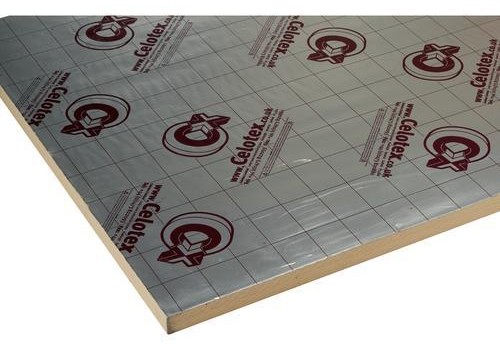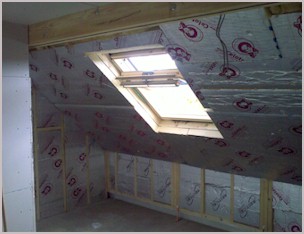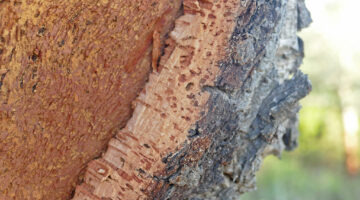
What are rigid boards?
 A rigid board is a compact material with insulation properties, which can be added to your roof, walls, ceilings or floor to help improve the energy efficiency of your property. The boards come in different thicknesses, and as per usual when it comes to insulation, the thicker you go for, the better in terms of energy efficiency.
A rigid board is a compact material with insulation properties, which can be added to your roof, walls, ceilings or floor to help improve the energy efficiency of your property. The boards come in different thicknesses, and as per usual when it comes to insulation, the thicker you go for, the better in terms of energy efficiency.
A rigid board is a compact material with insulation properties, which can be added to your roof, walls, ceilings or floor to help improve the energy efficiency of your property. The boards come in different thicknesses, and as per usual when it comes to insulation, the thicker you go for, the better in terms of energy efficiency.
When comparing these rigid boards to wool insulation, they tend to have much better heat retention properties; in fact you have to need to use twice as much wool to reach the same levels of energy efficiency as the rigid board.
What types of rigid boards are suitable for the loft?
Companies such as Celotex and Kingspan make boards that you can source for yourself an install in the loft as a DIY job. The boards that are produced by these manufacturers are easy to spot as they have a foil coating on one or both sides to help reflect heat back into the space you are trying to insulate. If the foil is only on one side, and you want to use these boards to insulate your rafters, you need to ensure the foiled side is pointing towards you when you install it, this ensures the heat is being reflected back in to the home.
Different types of rigid boards exist and the three most popular ones used are PIR (polyisocyanurate), phenolic and polystyrene boards.
PIR boards
PIR boards have great thermal efficiency (50% better than polystyrene) and the production process doesn’t emit any materials that are harmful to the environment. The material has been extensively tested for performance and is fire proof, which makes it a very effective compound to use in the loft space and helps to meet current building regulations.
Phenolic boards
These boards are highly efficient and have lower U values (see below) than the PIR boards for a given level of thickness. However, they are normally more expensive than the equivalent PIR boards. These Phenolic boards are also fire resistant despite being made from an oil compound, making them ideal to situate in your home.
Polystyrene boards
Polystyrene has been used for a number of years and has the history of good thermal retention. It can also be cut and moulded into shapes better than some of the other alternatives and since it is more mainstream it tends to be much cheaper. The major issue with this type of board is that it is flammable, therefore you should look to use the PIR or Phenolic boards if money allows.
Rigid boards and U values
U values are important to understand when trying to insulate the roof space. The lower the U value that is achieved post insulation the better the heat retention in the loft. For example when using a typical rigid board of 50mm, it is equivalent to a U value of around 0.4, 100mm is equivalent to 0.25 and 150mm and thicker is a U value of 0.2 or lower.
Where can I buy rigid boards?
Rigid boards can be bought at your local DIY store or they can be sourced from a specialist wholesaler online. Whether you are buying the product online or at the store you still need to get the measurements right so you know how much of the stuff you need to buy. You can like I do visit the DIY store and have a look at how the product looks like. When you are happy, you can go back online and purchase it as very often this will give you a further saving.
What thickness of board is available?
Rigid boards are sold with different thicknesses. They start at 20mm and go up in 10-15mm increments up to 200mm.
How do I handle rigid boards as a DIY job?
If you are installing rigid boards you can either install them at the joist level, which is above the ceiling or at the rafter level, which is below the roof. Please see our guide on whether you are after a cold or warm roof, as this will determine where you put the rigid boards. If you are going to install them at joist level and you intend to walk on the boards, we recommend putting a layer of chipboard on top since this will help spread your weight across the joists.
How do I measure and cut them to fit a joist or rafter space?
You will need to make sure that when you cut the material that it fits tightly in loft joist / rafter space. You can use a combination of cutting tools from a Stanley knife, a fine-toothed saw or actually equipping yourself with a rigid board cutter.
Measuring it absolutely key and getting it right first time is important as you don’t want to be throwing materials away.
Also when cutting just ensure you handle the tools with care.












This seems a more sensible and user friendly insulation than the fluffy kind. How does it compare on price?
My loft is boarded out and used as a hobby room . I need to make the roof look better from inside and thought of insulation boards between the rafters . Will this cause damp in the loft . The loft already has full insulation below the floor .
Hi Ellen, it is more expensive to be honest, and actually a lot more fiddly to do because you need to cut the boards so they fit between the joists. That being said, as you say it is far nicer to work with than the wool because it is less itchy and also you can use thinner material to achieve the same u-value.
My loft has an area with low depth of ins. with fibreboard on top to make a storage space. I want to keep the space available, so can I put rigid boards or other ins. on top of the present board and be able to walk on it? This is about 4m x .9m
Hi Jan,
We would always recommend attaching rigid chipboard in the loft to the joists to allow you to walk safely across it. While the fibreboard is relatively strong, if you walk on it where it is not supported (between joists) it could crack.
Another useful advantage of rigid PIR and Phenolic boards is that they do not run, melt or drip when exposed to fire – an important fire safety difference.
Finally, a useful tip for cutting rigid insulation boards is, believe it or not, a bread knife.
Peter
Thanks for the tip peter – much appreciated!
I live in a large stone-built house with absolutely no insulation. I have two questions:
1. The staircase extends right up to my attic space (a small landing with two large attic rooms on either side accessed through a normal doors). Both attic rooms Completely floored. although not being the best solution to retain heat in the rooms below, would it be better to use rigid boards between/underneath the rafters rather than lifting the floorboards and insulating between the joists.
2. as I progressively redecorate, is it worth lifting the floorboards (on the suspended floors) downstairs and placing rigid boards between the joists or is this not worth the hassle/expense. .
I’d like to install rigid board in my loft (between the joists). Although you explain that the foil side should face the installer for insulating the rafters, you don’t state which side the foil should face when installing between joists.
I’m a complete newby at loft insulation but love the idea of being able to use (almost) half the thickness of wool for the same performance.
Also, can I completely replace the existing (old) wool for the rigid insulation?
I’d like to put some board over the insulation (attached to the joists) for storage but having a low pitch roof the thought of rigid insulation is becoming more favourable…
Any advice greatly appreciated.
Thank you!
thats fine but where must the fish go?
Can solid board insulation i.e. Kingspan be laid on top of the ceiling joists instead of cutting to fit between the joists
I wish to insulate my loft. The joist are 80mm deep. I was contemplating having 75mm sheep wool between them and some boards across. How deep should they be? Is this an efficient suggestion? What boards are best?
Are you going to review your advice on the installation of PIR and other similar products following the Grenfell fire disaster. The Celotex FR5000 product was a component of the cladding used at Grenfell Tower. The Class ‘O’ fire resistance rating used to promote this product (as safe?) relates to rating under Approved Document B of the Building Regulations 1991- The AD-B has been amended a number of times, not least in May 2020 following the recent fire disaster. Yes insulating your home is important if we are to meet the 2050 UK Government target for Net Zero Carbon Emission homes, However benefit will be of little value if adequate Fire safety advice remains unavailable at our cost in the interim.
Can celotex/kingspan be applied across joists, rather than cutting and fitting between?
Yes as long as the span between joists is no greater than 565mm